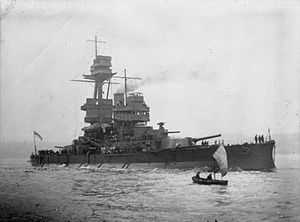Bjørgvin-class coastal defence ship
 Bjørgvin as HMS Glatton | |
| Class overview | |
|---|---|
| Operators: |
|
| Preceded by: | Eidsvold-class battleship |
| Succeeded by: | None |
| Built: | 1912–1914 |
| In commission: | 1914–1928 |
| Completed: | 2 |
| Lost: | 1 |
| General characteristics | |
| Type: | Coastal defence ship |
| Displacement: | 4,900 long tons (4,979 t) |
| Length: | 94 m (308 ft 5 in) |
| Beam: | 16.8 m (55 ft 1 in) |
| Draught: | 5.4 m (17 ft 9 in) |
| Propulsion: | Coal-fired reciprocating steam engines, 4,000 shp (2,983 kW) |
| Speed: | 15 knots (17 mph; 28 km/h) |
| Complement: | 305 |
| Armament: | 2 × 24 cm (9.4 in) guns 4 × 15 cm (5.9 in) guns 6 × 10 cm (3.9 in) guns 2 × submerged torpedo tubes |
| Armour: | Belt: 7 in (180 mm) Bulkheads: 4 in (100 mm) Barbettes: 8 in (200 mm) Turrets: 8 in (200 mm) Decks: 2.5 in (64 mm) Conning tower: 8 in (200 mm) |
The Bjørgvin class coastal battleships were ordered by Norway in 1912 to supplement the older Eidsvold and Tordenskjold-class coastal defence ships. The two ships laid down were compulsorily purchased by the Royal Navy when World War I broke out, and classified as monitors. The British government paid Norway £370,000 as compensation for each ship.
Ships in class
- Bjørgvin (1912) - Compulsorily purchased by the British Navy and renamed HMS Glatton, blew up in September 1918.
- Nidaros (1912) - Compulsorily purchased by the British Navy and renamed HMS Gorgon.
Description
The Bjørgvin class would be significantly more heavily armed than the previous Eidsvold class:
- Two 24 cm/50 guns, which in British service were relined to use standard British ammunition and became 9.2"/51.[1] These were considered among the longest-ranged guns in the world in 1918. As designed, they would have fired a 190 kg (419 lb) projectile with a muzzle velocity of 884 m/s (2,900 ft/s), capable of penetrating 22.2 cm (8.75 in) of face-hardened armour at a range of 7,000 m (7,650 yards).
- Four 15 cm/50 in single turrets - one aft, one fore, two midships (one on either side). In British service they were relined to take standard 6 inch (15 cm) ammunition.[2]
- Six 10 cm (3.94 in) guns.
- Two submerged torpedo tubes.
In addition to the heavier armament, the two ships of the Bjørgvin class were also significantly better armoured, with her armour better distributed:
- 7 inch (17.78 cm) thick armour in the belt
- 8 inch (20.32 cm) thick armour on the turrets
- 8 inch (20.32 cm) thick armour in the barbettes
- 2.5 inch (6.35 cm) thick armoured deck
- 8 inch (20.32 cm) thick armour on the conning tower
- 4 inch (10,16 cm) thick armoured bulkheads
External links
- Model of KNM Bjørgnvin, head on view
- Details of the forecastle and details of bridge.
- The loss of the HMS Glatton, an "interesting little ship", retrieved 15 January 2007
Notes
- ↑ British 9.2"/51 (23.4 cm) Mark XII, updated 8 April 2005, retrieved 9 December 2005
- ↑ British 6"/49 (15.2 cm) BL Mark XVIII, updated 1 April 2005, retrieved 9 December 2005
References
- Model of KNM Bjørgnvin, from the website of the Norwegian Armed Forces Museum, retrieved 9 December 2005
- On guns, see Notes.
- Naval History via Flix: KNM Nidaros, retrieved 11 December 2005
- Naval History via Flix: Technical Details of Ship HMS Gorgon, retrieved 9 December 2005
| ||||||||||||||||||